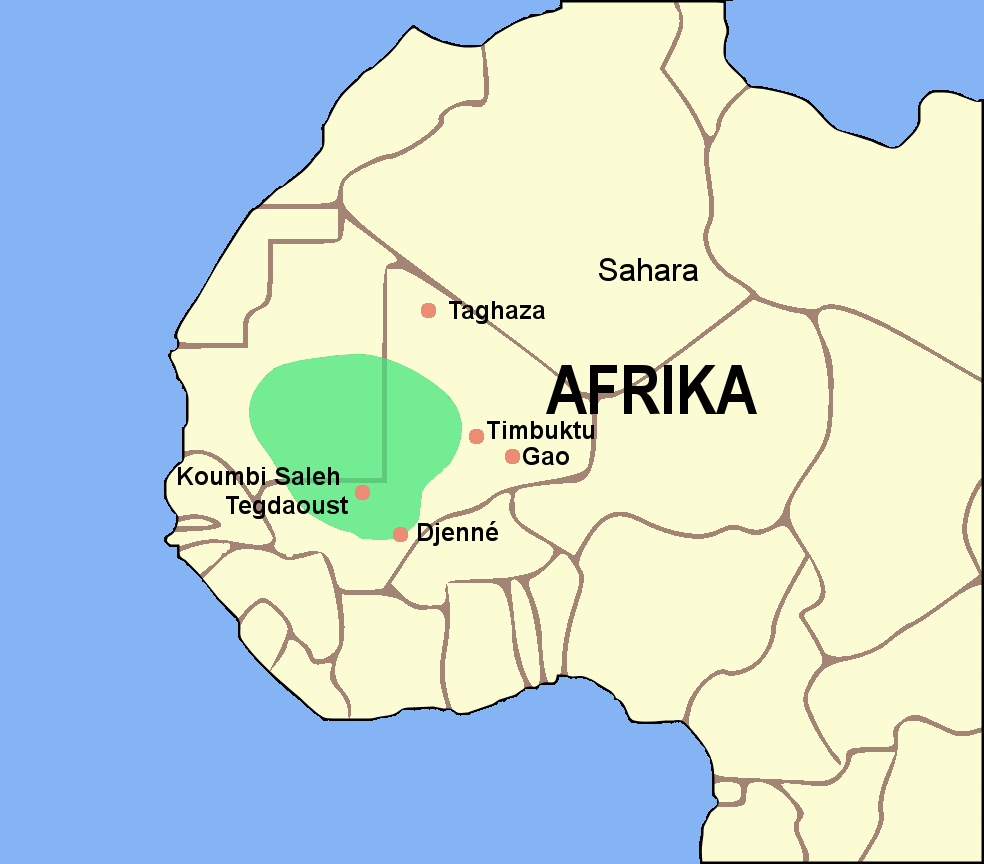「大至之戰」修訂間的差異
| 行 1: | 行 1: | ||
[[分類:古代戰爭]] | [[分類:古代戰爭]] | ||
| − | == | + | ==開始== |
<img src='https://upload.wikimedia.org/wikipedia/commons/1/18/Ghana_empire_map.png' width=500 height=*/> | <img src='https://upload.wikimedia.org/wikipedia/commons/1/18/Ghana_empire_map.png' width=500 height=*/> | ||
| − | + | 鑑於阿拉伯文獻的分散性質和現有考古記錄的模糊性,很難確定加納何時以及如何衰落。對帝國的最早描述是模糊的,儘管根據巴克里(al-Bakri)的說法,加納在 970 年至 1054 年之間的某個時間點迫使沙漠中的Awdaghost人接受了它的統治。然而,到了巴克里的時代,它已被如西拉等強大的王國包圍。 1240年加納併入馬里王國,標誌著加納帝國的終結。 | |
| − | + | 歷史編纂學的一個傳統認為,加納在 1076-77 年被阿摩拉維德王朝洗劫時淪陷,儘管加納人抵抗了十年的進攻,但這種解釋受到了質疑。 康拉德和費舍爾 (1982) 認為,任何阿摩拉維軍事征服的傳說只是民間傳奇,源於對阿拉伯語資料的誤解或天真依賴。此外,古代加納的考古學沒有顯示出與任何阿摩拉維時代的軍事征服有關的快速變化和破壞的跡象。 | |
| − | + | 雖然在當代資料中沒有關於加納被解僱的明確記載,但該國確實皈依了伊斯蘭教,因為艾德里西(al-Idrisi)的記載寫於 1154 年,到那時該國已經完全是穆斯林了。 14 世紀北非歷史學家伊本·哈爾敦 (Ibn Khaldun) 曾閱讀並引用了巴克里和艾德里西的著作,他報告了一位法基人“奧斯曼 ('Uthman)”對加納國家歷史的模棱兩可的描述。根據該報告,加納的權力隨著阿爾摩拉維德的“蒙面人”的權力增強而減弱。艾德里西的報告沒有給出任何理由使人相信帝國比 75 年前的巴克里時代更小或更弱。甚至,他將其首都描述為“蘇丹所有城鎮中面積最大、人口最多、貿易最廣泛的城鎮”。然而,根據大馬里(al-Umari)的詳細記述,很明顯,加納被併入了之後的馬里帝國,該記述寫於 1340 年左右,但基於“真實可信”的謝赫阿布·奧斯曼·賽義德 (Abu Uthman Sa'id al) 向他提供的證詞。 -Dukkali,長期居民。在 al-'Umari/al-Dukkali 的版本中,加納仍然保留其作為帝國內部某種王國的職能,它的統治者是唯一被允許冠以“馬利克”頭銜的人,並且“對他來說就像一個副手.” | |
| − | ==== | + | ==== 索索佔領和繼承國家 ==== |
| + | 據伊本·哈爾敦 (Ibn Khaldun) 稱,在加納皈依之後,“加納統治者的權威逐漸減弱,蘇蘇人征服並製服了他們。”一些現代傳統認為蘇蘇人是卡尼亞加的居民索索人。 | ||
| − | + | 索索人的歷史可以追溯到 12 世紀和 13 世紀被稱為“索索”的卡尼亞加王國。隨著加納帝國的垮台,索索帝國擴張到了許多以前迦納的領地,包括其首都庫姆比·薩利赫(Koumbi Saleh)。根據後來的傳統,迪亞拉·坎特控制了庫姆比·薩利赫並建立了迪亞里索王朝。他的兒子蘇馬奧羅·坎特繼位,並強迫人民向他進貢。索索帝國還設法吞併了南部鄰近的州康巴,那裡有重要的金礦。在蘇馬奧羅·坎特國王的統治下,索索人短暫地征服了現在馬里的曼丁卡王國。但在基里納之戰(約 1235 年)中,但當曼丁卡王子松迪亞塔·凱塔 (Sundiata Keita) 率領小國聯盟徹底擊敗索索帝國,從而開始了馬里帝國時,這些成果也都消失了。松迪亞塔向索索城進軍並摧毀了它,標誌著王國的終結。 | |
| + | <img src='https://upload.wikimedia.org/wikipedia/commons/e/ef/Mauritania_location_map.svg' width=500 height=*/> | ||
| + | <img src='https://upload.wikimedia.org/wikipedia/commons/5/57/Ghana_successor_map_1200.png' width=500 height=*/> | ||
| − | + | 根據古老的非洲歷史學家的說法,蘇馬奧羅·坎特 (Sumaoro Kante) 被認為是他王國的一位殘忍、嚴厲的領導人。他的領導風格保持了帝國的平衡,並導致了民族國家內部的組織。在他的統治下,經濟上也取得了巨大的成功。據說他使用“魔法”來嚇唬他的人民並保持他的王國團結。 | |
| − | + | 加納帝國垮台後,索索帝國繼承了加納帝國。蘇曼古魯在位期間攻占了康巴巴州,後來成為馬里州。 蘇馬奧羅在嚴酷的統治下控制他的人民,直到他最終被非洲民間傳說英雄松迪亞塔推翻。松迪亞塔小時候就被從他在帝國的家中流放。然而,他周遊各國,集結盟軍與他作戰,在1235年的克里納之戰中與蘇馬奧羅作戰。在那裡,松迪亞塔取得勝利並接管了索索帝國,結束了帝國的統治。 | |
| − | + | ==松迪亞塔·凱塔== | |
| − | + | 與松迪亞塔·凱塔 (Sundiata Keita) 相關的口頭傳統由當地的 griots (或djeli和jeliw,一種吟遊詩人) 一代又一代地傳承下來,直到最終他們的故事被寫成文字。松迪亞塔 (也被稱為 Manding Diara,馬里的獅子,Sogolon Djata,Nare Maghan,Sogo Sogo,Simbon Salaba) 是納雷·馬漢·科納特 (Naré Maghann Konaté)(變體:Maghan Konfara)和索格隆康德 (Sogolon Condé)(變體:“Sogolon Kolonkan”或“Sogolon Kédjou”,一位“水牛女人”的女兒,因其醜陋和駝背而得名)的兒子。 松迪亞塔從小就殘疾,他的母親(Sogolon)常是其他婦人們嘲笑的對象。她經常因為兒子的殘疾而被公開取笑。這對松迪亞塔產生了重大影響,他決心盡其所能,以便像他的同齡人一樣走路。憑著這份決心,他有一天奇蹟般的起身開始走。在同齡人中,他成為了領導者。他的同父異母兄弟丹卡蘭·圖曼 (Dankaran Touman) 和丹卡蘭的母親薩蘇馬·貝雷特 (Sassouma Bereté) 對松迪亞塔和他的母親非常殘忍和怨恨。在納雷·馬漢(松迪亞塔的國王和父親)死後,他們的殘忍程度升級了。為了逃避迫害和對她兒子生命的威脅,索格隆帶著松迪亞塔和他的姐妹們流亡國外。這流亡持續了很多年,並將他們帶到加納帝國內的不同國家,並最終帶到了梅瑪,在那裡梅瑪的國王給予了他們的庇護。松迪亞塔因其勇敢和堅韌而受到梅瑪國王的欽佩。因此,他在王國中獲得了高級職位。在索索國王蘇馬奧羅·坎特征服曼丁卡人後,信使們被派去尋找索戈隆和她的孩子們,因為根據預言,桑迪亞塔注定會成為一位偉大的領袖。信使們在梅瑪找到他後,倒戈而說服他回來以解放曼丁卡人和他們的家園。他回來時,有一支由梅瑪國王賜予他的軍隊陪伴著他。當時屬於他年齡組的馬里軍閥包括:塔邦瓦納 (Tabon Wana)、卡馬迪亞卡馬拉 (Kamadia Kamara)(或 Kamadia Camara)、法妮·康德 (Faony Condé)、希拉·庫曼·科納特 (Siara Kuman Konaté) 和 和蒂拉瑪汗·特拉奧雷( Tiramakhan Traore 或“Trimaghan”或“Tiramaghan”,卡布帝國的未來征服者)。正是在 西比(Siby 或 Sibi) 平原上,他們結成了兄弟會,以從強大的索索國王手中解放他們的國家和人民。在基里納之戰中,松迪亞塔和他的盟友擊敗了索索國王,並成為了馬里帝國的第一任皇帝。他是曼丁卡王系中第一個採用王室頭銜曼薩(曼丁卡語中的國王或皇帝)的國王。 | |
| + | 曼丁卡史詩沒有給我們日期,但在史詩事件發生大約一個世紀後訪問該地區的阿拉伯和北非作家在紙上記錄了一些信息,包括日期和家譜。相反,書面資料遺漏了許多口頭傳統包括的其他信息。 | ||
| + | |||
| + | Sundiata 名字的正確英文拼寫是 Sunjata,發音為 Soon-jah-ta,接近原始 Mandinka 中的實際發音。 Sogolon 的名字來源於他的母親,Jata 的意思是獅子。這是在一些西非社會(特別是岡比亞、塞內加爾、馬里和幾內亞)讚美某人的傳統方式。 Sundiata 這個名字通過他的母親來讚美他,意思是“Sogolon 的獅子”或“Sogolon 的獅子”。 Jata這個名字來源於Jara(獅子)。 Jara 及其許多變體,如 jata、jala 或 jada 僅僅是區域變體,例如來自岡比亞、幾內亞或馬里。 Sundiata 的名字因此是他母親名字 Sogolon(兒子或它的變體太陽)和 Jata(獅子)的派生詞。 | ||
於 2021年12月27日 (一) 11:35 的修訂
開始

鑑於阿拉伯文獻的分散性質和現有考古記錄的模糊性,很難確定加納何時以及如何衰落。對帝國的最早描述是模糊的,儘管根據巴克里(al-Bakri)的說法,加納在 970 年至 1054 年之間的某個時間點迫使沙漠中的Awdaghost人接受了它的統治。然而,到了巴克里的時代,它已被如西拉等強大的王國包圍。 1240年加納併入馬里王國,標誌著加納帝國的終結。
歷史編纂學的一個傳統認為,加納在 1076-77 年被阿摩拉維德王朝洗劫時淪陷,儘管加納人抵抗了十年的進攻,但這種解釋受到了質疑。 康拉德和費舍爾 (1982) 認為,任何阿摩拉維軍事征服的傳說只是民間傳奇,源於對阿拉伯語資料的誤解或天真依賴。此外,古代加納的考古學沒有顯示出與任何阿摩拉維時代的軍事征服有關的快速變化和破壞的跡象。 雖然在當代資料中沒有關於加納被解僱的明確記載,但該國確實皈依了伊斯蘭教,因為艾德里西(al-Idrisi)的記載寫於 1154 年,到那時該國已經完全是穆斯林了。 14 世紀北非歷史學家伊本·哈爾敦 (Ibn Khaldun) 曾閱讀並引用了巴克里和艾德里西的著作,他報告了一位法基人“奧斯曼 ('Uthman)”對加納國家歷史的模棱兩可的描述。根據該報告,加納的權力隨著阿爾摩拉維德的“蒙面人”的權力增強而減弱。艾德里西的報告沒有給出任何理由使人相信帝國比 75 年前的巴克里時代更小或更弱。甚至,他將其首都描述為“蘇丹所有城鎮中面積最大、人口最多、貿易最廣泛的城鎮”。然而,根據大馬里(al-Umari)的詳細記述,很明顯,加納被併入了之後的馬里帝國,該記述寫於 1340 年左右,但基於“真實可信”的謝赫阿布·奧斯曼·賽義德 (Abu Uthman Sa'id al) 向他提供的證詞。 -Dukkali,長期居民。在 al-'Umari/al-Dukkali 的版本中,加納仍然保留其作為帝國內部某種王國的職能,它的統治者是唯一被允許冠以“馬利克”頭銜的人,並且“對他來說就像一個副手.”
索索佔領和繼承國家
據伊本·哈爾敦 (Ibn Khaldun) 稱,在加納皈依之後,“加納統治者的權威逐漸減弱,蘇蘇人征服並製服了他們。”一些現代傳統認為蘇蘇人是卡尼亞加的居民索索人。
索索人的歷史可以追溯到 12 世紀和 13 世紀被稱為“索索”的卡尼亞加王國。隨著加納帝國的垮台,索索帝國擴張到了許多以前迦納的領地,包括其首都庫姆比·薩利赫(Koumbi Saleh)。根據後來的傳統,迪亞拉·坎特控制了庫姆比·薩利赫並建立了迪亞里索王朝。他的兒子蘇馬奧羅·坎特繼位,並強迫人民向他進貢。索索帝國還設法吞併了南部鄰近的州康巴,那裡有重要的金礦。在蘇馬奧羅·坎特國王的統治下,索索人短暫地征服了現在馬里的曼丁卡王國。但在基里納之戰(約 1235 年)中,但當曼丁卡王子松迪亞塔·凱塔 (Sundiata Keita) 率領小國聯盟徹底擊敗索索帝國,從而開始了馬里帝國時,這些成果也都消失了。松迪亞塔向索索城進軍並摧毀了它,標誌著王國的終結。

根據古老的非洲歷史學家的說法,蘇馬奧羅·坎特 (Sumaoro Kante) 被認為是他王國的一位殘忍、嚴厲的領導人。他的領導風格保持了帝國的平衡,並導致了民族國家內部的組織。在他的統治下,經濟上也取得了巨大的成功。據說他使用“魔法”來嚇唬他的人民並保持他的王國團結。
加納帝國垮台後,索索帝國繼承了加納帝國。蘇曼古魯在位期間攻占了康巴巴州,後來成為馬里州。 蘇馬奧羅在嚴酷的統治下控制他的人民,直到他最終被非洲民間傳說英雄松迪亞塔推翻。松迪亞塔小時候就被從他在帝國的家中流放。然而,他周遊各國,集結盟軍與他作戰,在1235年的克里納之戰中與蘇馬奧羅作戰。在那裡,松迪亞塔取得勝利並接管了索索帝國,結束了帝國的統治。
松迪亞塔·凱塔
與松迪亞塔·凱塔 (Sundiata Keita) 相關的口頭傳統由當地的 griots (或djeli和jeliw,一種吟遊詩人) 一代又一代地傳承下來,直到最終他們的故事被寫成文字。松迪亞塔 (也被稱為 Manding Diara,馬里的獅子,Sogolon Djata,Nare Maghan,Sogo Sogo,Simbon Salaba) 是納雷·馬漢·科納特 (Naré Maghann Konaté)(變體:Maghan Konfara)和索格隆康德 (Sogolon Condé)(變體:“Sogolon Kolonkan”或“Sogolon Kédjou”,一位“水牛女人”的女兒,因其醜陋和駝背而得名)的兒子。 松迪亞塔從小就殘疾,他的母親(Sogolon)常是其他婦人們嘲笑的對象。她經常因為兒子的殘疾而被公開取笑。這對松迪亞塔產生了重大影響,他決心盡其所能,以便像他的同齡人一樣走路。憑著這份決心,他有一天奇蹟般的起身開始走。在同齡人中,他成為了領導者。他的同父異母兄弟丹卡蘭·圖曼 (Dankaran Touman) 和丹卡蘭的母親薩蘇馬·貝雷特 (Sassouma Bereté) 對松迪亞塔和他的母親非常殘忍和怨恨。在納雷·馬漢(松迪亞塔的國王和父親)死後,他們的殘忍程度升級了。為了逃避迫害和對她兒子生命的威脅,索格隆帶著松迪亞塔和他的姐妹們流亡國外。這流亡持續了很多年,並將他們帶到加納帝國內的不同國家,並最終帶到了梅瑪,在那裡梅瑪的國王給予了他們的庇護。松迪亞塔因其勇敢和堅韌而受到梅瑪國王的欽佩。因此,他在王國中獲得了高級職位。在索索國王蘇馬奧羅·坎特征服曼丁卡人後,信使們被派去尋找索戈隆和她的孩子們,因為根據預言,桑迪亞塔注定會成為一位偉大的領袖。信使們在梅瑪找到他後,倒戈而說服他回來以解放曼丁卡人和他們的家園。他回來時,有一支由梅瑪國王賜予他的軍隊陪伴著他。當時屬於他年齡組的馬里軍閥包括:塔邦瓦納 (Tabon Wana)、卡馬迪亞卡馬拉 (Kamadia Kamara)(或 Kamadia Camara)、法妮·康德 (Faony Condé)、希拉·庫曼·科納特 (Siara Kuman Konaté) 和 和蒂拉瑪汗·特拉奧雷( Tiramakhan Traore 或“Trimaghan”或“Tiramaghan”,卡布帝國的未來征服者)。正是在 西比(Siby 或 Sibi) 平原上,他們結成了兄弟會,以從強大的索索國王手中解放他們的國家和人民。在基里納之戰中,松迪亞塔和他的盟友擊敗了索索國王,並成為了馬里帝國的第一任皇帝。他是曼丁卡王系中第一個採用王室頭銜曼薩(曼丁卡語中的國王或皇帝)的國王。 曼丁卡史詩沒有給我們日期,但在史詩事件發生大約一個世紀後訪問該地區的阿拉伯和北非作家在紙上記錄了一些信息,包括日期和家譜。相反,書面資料遺漏了許多口頭傳統包括的其他信息。
Sundiata 名字的正確英文拼寫是 Sunjata,發音為 Soon-jah-ta,接近原始 Mandinka 中的實際發音。 Sogolon 的名字來源於他的母親,Jata 的意思是獅子。這是在一些西非社會(特別是岡比亞、塞內加爾、馬里和幾內亞)讚美某人的傳統方式。 Sundiata 這個名字通過他的母親來讚美他,意思是“Sogolon 的獅子”或“Sogolon 的獅子”。 Jata這個名字來源於Jara(獅子)。 Jara 及其許多變體,如 jata、jala 或 jada 僅僅是區域變體,例如來自岡比亞、幾內亞或馬里。 Sundiata 的名字因此是他母親名字 Sogolon(兒子或它的變體太陽)和 Jata(獅子)的派生詞。